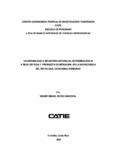| dc.contributor.advisor | Faustino, Jorge | |
| dc.contributor.author | Reyes Sandoval, Wilmer M. | |
| dc.date.accessioned | 2014-10-20T05:23:25Z | |
| dc.date.available | 2014-10-20T05:23:25Z | |
| dc.date.issued | 2003 | es_ES |
| dc.identifier | 365843 | es_ES |
| dc.identifier.uri | https://repositorio.catie.ac.cr/handle/11554/5365 | |
| dc.description | Tesis (Mag. Sc.) -- CATIE, 2003 | es_ES |
| dc.description.abstract | La microcuenca del Río Talgua en Honduras ha sufrido daños significativos por la ocurrencia de fenómenos naturales. Durante el primer semestre del 2003 se evaluó la vulnerabilidad y el riesgo en esta microcuenca, con el objetivo de identificar niveles y áreas con mayor grado de vulnerabilidad y riesgo a desastres, y proponer líneas de acción que permitan reducción y mitigación de la vulnerabilidad y el riesgo a desastres del área. Los resultados indican que la microcuenca presenta mayor vulnerabilidad en la parte técnica, institucional, física y económica; la menor vulnerabilidad la presenta en los componentes social y político. Finalmente, en base a los resultados del estudio y con una participación activa de los actores locales, se propusieron lineamientos para la reducción del riesgo y la vulnerabilidad en la microcuenca. | es_ES |
| dc.description.abstract | The Talgua watershed in Honduras was one of the most affected zones by the Mitch Hurricane, suffering significant damage. The vulnerability and risk to natural disasters were evaluated in this watershed during the first semester of 2003. The objective of this study was to identify levels and areas with greater vulnerability and risk to disasters, and to propose lines of action that permit the reduction and mitigation of vulnerability and risk to disasters in the area The results show that Talgua watershed presents greater vulnerability in economic, physical, institutional, and technical aspects; the lower vulnerability was present in the political and social components. Finally, upon integrating the vulnerable areas with the critical factors, the results conclude that the Talgua watershed presents risk percentages of 20 percent, 27 percent and 53 percent for low, medium high levels respectively. In addition, plans of action for the prevention and mitigation of vulnerability and risk to natural disasters were proposed. | |
| dc.language.iso | es | es_ES |
| dc.publisher | CATIE, Turrialba (Costa Rica) | es_ES |
| dc.relation.ispartof | Maestría en Manejo y Gestión en Cuencas Hidrográficas | |
| dc.subject | WATERSHEDS | |
| dc.subject | WATERSHED MANAGEMENT | |
| dc.subject | RESOURCE MANAGEMENT | |
| dc.subject | DISASTERS | |
| dc.subject | PHYSIOGRAPHIC FEATURES | |
| dc.subject | SIMULATION MODELS | |
| dc.subject | STATISTICAL METHODSCUENCAS HIDROGRAFICAS | |
| dc.subject | ORDENACION DE CUENCAS | |
| dc.subject | ORDENACION DE RECURSOS | |
| dc.subject | DESASTRES | |
| dc.subject | ASPECTOS FISIOGRAFICOS | |
| dc.subject | MODELOS DE SIMULACION | |
| dc.subject | METODOS ESTADISTICOS | |
| dc.subject | HONDURAS | |
| dc.title | Vulnerabilidad a desastres naturales, determinación de áreas críticas y propuesta de mitigación en la microcuenca del río Talgua, Catacamas, Honduras | |
| dc.type | Tesis de maestría | es_ES |
| dcterms.rights | acceso abierto | es_Es |
| dc.identifier.publication | Turrialba (Costa Rica) | es_ES |


